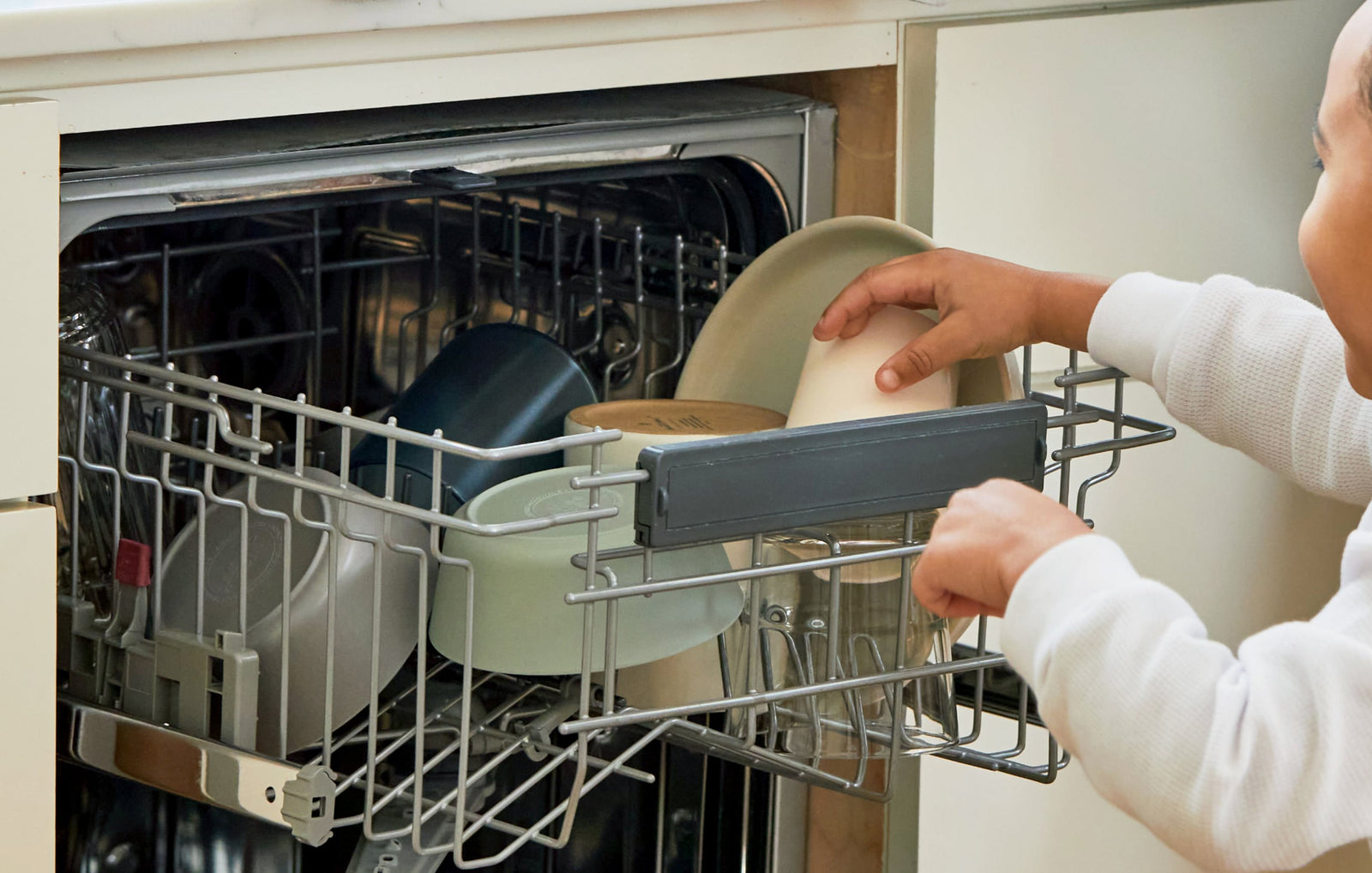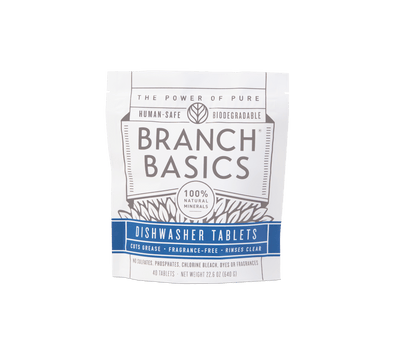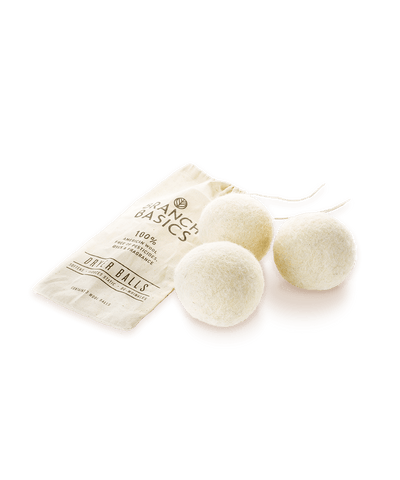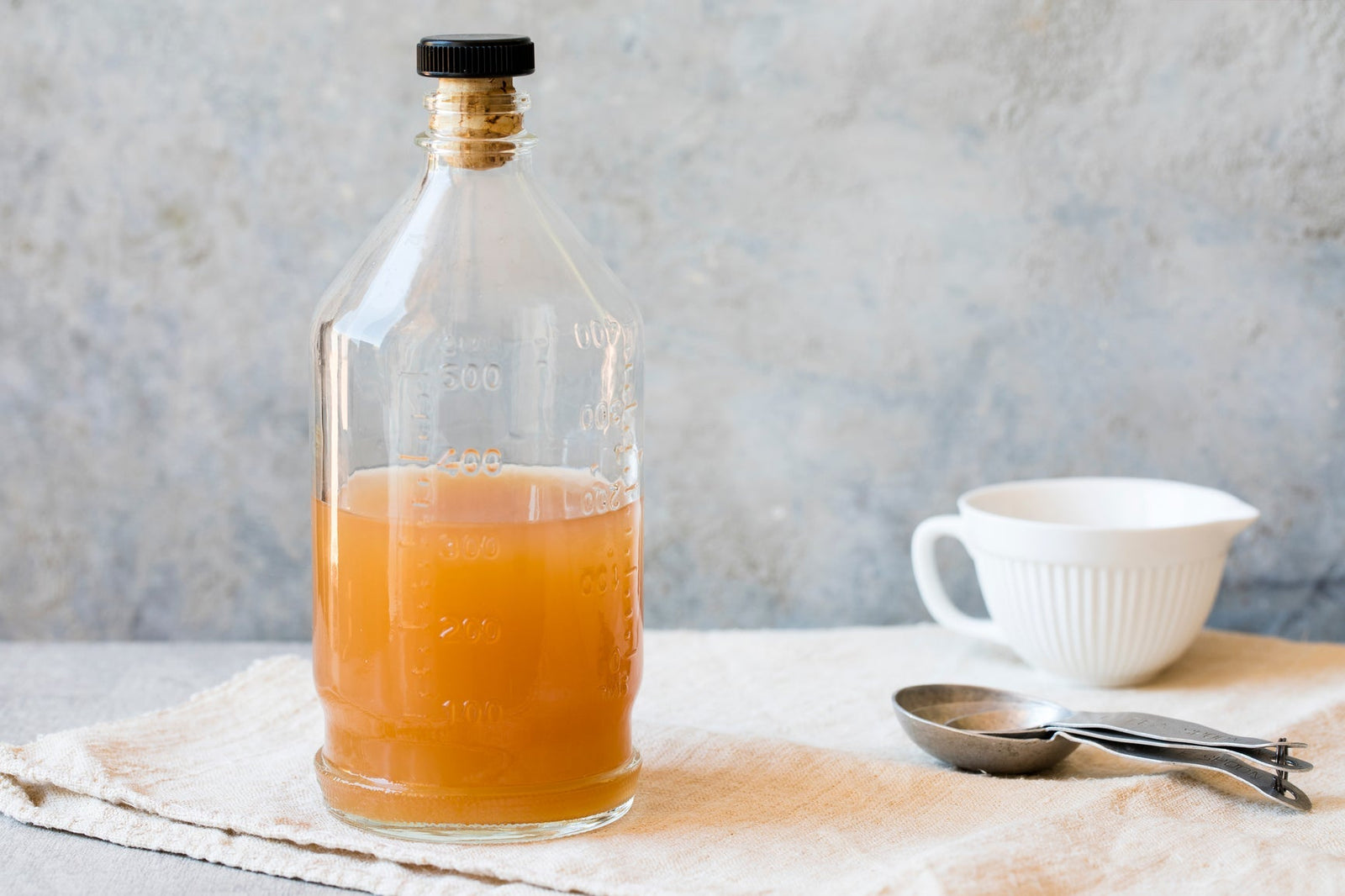How to Clean Your Dishwasher With Vinegar: Our Method | Branch Basics

Cleaning your dishwasher probably isn’t high on your to-do list.
But, did you know that this kitchen workhorse requires monthly (yep, you read that right - monthly!) maintenance cleanings, and a few yearly deep cleanings?
In this article, we give you step-by-step instructions on how to clean your dishwasher using vinegar - a natural, human-safe method that breaks down grease, food residue, and mineral deposits, leaving your dishwasher looking (and smelling) like brand-new. Note: Before you begin cleaning, check with the manufacturer to ensure these cleaning methods are safe and will not cause damage to the appliance.
How to Clean Your Dishwasher With Vinegar
Cleaning your dishwasher regularly with vinegar is an easy way to boost its performance and extend its lifespan.
Without proper and monthly cleanings, things like food particles, minerals, grease, grime, mold, bacteria, and conventional detergent residues can accumulate, affecting how well the dishwasher works. Over time, a lack of cleanings can (eventually) lead to expensive repairs that could have been avoided.
To keep your dishwasher in tip-top condition, follow the steps below on how to clean your dishwasher with vinegar.
What you’ll need:
-
Warm water
-
Distilled white vinegar*
-
Branch Basics All-Purpose and Concentrate (or other human-safe dish soap)
-
Old toothbrush
-
Toothpick
-
Microfiber cloths
-
Rubber cleaning gloves
*Note: Although vinegar is safe and natural, it is highly acidic and should be kept out of reach of children and pets. Vinegar contains acetic acid, which becomes an eye and lung irritant when sprayed. While using, make sure you avoid breathing the fumes and provide good ventilation to clear the air quickly of the acetic acid. If anyone in your home is sensitive to smells or has a respiratory issue, it’s best to not make vinegar or vinegar solutions airborne by spraying.
Reminder: Before you begin cleaning, check with the manufacturer to ensure these cleaning methods are safe and will not cause damage to the appliance. Most dishwashing manufacturers recommend using vinegar, a few do not.
Step 1: Remove and Clean Removable Parts
Before you begin cleaning, you’ll need to empty the dishwasher of all removable parts. This includes dish racks, utensil holders, and any dishes, cups, and silverware.
If the dishwasher is fairly dry, use a HEPA vacuum to remove any loose crumbs, food and debris.
Follow up with a deep clean of each dishwasher part.
Here’s how:
-
Spray everything down with Branch Basics All-Purpose, wipe with a microfiber cloth, and rinse.
For stubborn, stuck-on food or grime, soak in a sink of warm water, 1 tsp. Branch Basics Concentrate and 1-2 cups distilled white vinegar for 10-20 minutes. Wipe and rinse clean.
-
Set cleaned parts aside and move onto Step 2.
Step 2: Check, Clean and Unclog the Spraying Arm
-
Take off the spraying arm on the bottom and/or top of the dishwasher.
-
Look for and remove any clogs using a toothpick, sewing needle, or quilt pin.
-
Spray down with Branch Basics All-Purpose and wipe clean with a microfiber cloth.
-
Set aside.
Step 3: Spray and Clean Inside and Out of the Dishwasher
-
Next, spray the entire interior of the dishwasher with Branch Basics All-Purpose. Be sure to include the inside of the door, the basin on the bottom, and dishwasher walls.
-
Let dwell for 3-5 minutes.
-
Wipe clean with a microfiber cloth.
While you’re at it, be sure to check the door seal for any gunk and grime build-up. If you notice some, spray with All-Purpose and scrub with a toothbrush.
For tough build-up, follow with some distilled white vinegar. Let sit for about 20 minutes, then scrub again. Wipe clean with a microfiber cloth.
And don’t forget the exterior dishwasher door! Here are a few tips:
-
If the door is made of stainless steel, we recommend reading Cleaning Stainless Steel Naturally: 7 Simple Methods. This blog will guide you on how to use human-safe, natural cleaners that won’t leave streaks or scratch the steel.
-
For other (and most) dishwasher door materials, Branch Basics All-Purpose and a microfiber cloth should do the trick! Spray and wipe clean*.
*Note: Avoid spraying the control panel directly as it may cause damage. Instead, lightly dampen a microfiber cloth with All-Purpose and/or distilled white vinegar and wipe clean.
Step 4: Run a Full Cycle with Vinegar
Now it’s time to run a full cycle to clean your dishwasher with vinegar.
Here’s how:
-
Replace all dish racks and removable parts.
-
Fill a dishwasher safe mug or glass measuring cup with 1-2 cups distilled white vinegar.
-
Place the cup in the center of your dishwasher’s top rack with no other dishes.
-
Run a full cycle with hot water.
-
Open the dishwasher immediately after the cycle is complete to air dry.
How does it work?
The acidic nature of vinegar breaks down any bits of food, grease, soap scum and grime. The dishwasher cycles the vinegar through its filter and spray arms, dispersing it throughout the central tub. This cleaning cycle completes a thorough clean of your dishwasher.
For more, check out 12 Ways to Use Vinegar in Your Home.
How to Keep Your Dishwasher Clean
In addition to regular cleanings, there are a few important steps you can take to help keep your dishwasher clean and running well:
-
Leave the door slightly open after each cycle to allow the interior to air dry.
-
Regularly check and clean the dishwasher filter(s) and drain to avoid clogs.
-
Perform regular deep cleans.
-
And, toss conventional dish detergents. Opt instead for a plant and mineral-based option like Branch Basics Dishwasher Tabs.
Read on for more!
Let the Dishwasher Air Dry
After each use, it’s important to let the dishwasher air dry. This is helpful for several reasons:
-
Prevents the growth of harmful mold and bacteria - Leaving the dishwasher door open, when not in use, helps keep the interior cool and dry. This prevents the growth of mold and bacteria inside the basin and around the door’s seal.
-
Increases drying time - Immediately after each wash cycle, open the door an inch or two. This allows the steam to escape, helping the dishes and dishwasher to dry quicker.
-
Reduces and prevents odor - This is especially important if you load the dishwasher over time. Dirty dishes, even those that have been scraped off and rinsed, can cause bacteria-induced smells.
For best results, plan to leave the dishwasher door open one to two inches when it’s not in use.
Clean the Filter
Although it’s a small component, your dishwasher’s filter has a big job. As a wash cycle runs, the filter works to prevent food particles and grime from recirculating back through the spray arms.
You’ll know the filter is clogged if your dishes come out dirty (or worse, dirtier than before). If this is the case, it may be time to remove and clean the filter.
Here’s how:
-
Manually unlock and gently remove the filter(s).
-
Check the filter base inside the dishwasher for trapped food and remove. Wipe with a damp microfiber cloth.
-
Spray the filter(s) with Branch Basics All-Purpose. For extra dirty, gunked-up filter(s), let the spray dwell for 5-10 minutes.
If that doesn’t do the trick, soak the filter(s) in hot water to cover. Add 1 tsp. Branch Basics Concentrate and a scoop of Oxygen Boost. Let sit for about 15 minutes. -
Scrub with a toothbrush to remove any grease or stuck-on food.
-
Rinse and continue to scrub the filter(s) under warm running water.
-
Replace the filter(s) and make sure they’re locked in (if applicable).
As a general rule of thumb, plan to check and clean your dishwasher’s filter at least once a month. But if you’re good about scraping and rinsing dishes before loading, some manufacturers say it’s ok to clean every 6 to 12 months.
Clean the Drain
The drain is the circular piece underneath the bottom sprayer where the water drains out. Keeping the drain clean prevents clogs, reduces odors, and extends the life of your dishwasher.
To clean:
-
Remove with a screwdriver, or it may just twist and pop out with your hands.
-
Spray the drain and basin below with Branch Basics All-Purpose.
-
Scrub, then wipe clean with a microfiber cloth.
-
Screw or pop the drain back in place.
To clean using vinegar and baking soda, try this method:
-
Pour 1 cup distilled white vinegar into a measuring cup.
-
Add 2 tablespoons of baking soda and stir until well combined.
-
Pour the fizzy solution into the drain and let dwell for 10-15 minutes.
-
In the meantime, boil a small pot of water. Carefully pour the boiling water into the drain.
-
Wipe with a microfiber cloth and replace the filter (if it was removed for cleaning).
If you’re looking for an even deeper clean, check out Step 4 in How to Deep Clean Your Dishwasher for a vinegar, hot water, and Oxygen Boost method.
How Often Should You Clean Your Dishwasher?
For optimal performance, many manufacturers recommend cleaning your dishwasher once a month, or bi-monthly. Routine cleanings help reduce build-up of food, grime, limescale, mold, and odor-causing bacteria.
This, of course, depends on how often you use your dishwasher and how dirty it gets over time.
We recommend following our vinegar routine once a month, and perform a deep clean often.
If you don’t have time to clean your dishwasher each month, then we recommend doing a weekly vinegar rinse, wipe the interior down, and commit to quarterly cleanings. You can also check with your manufacturer for their recommendations.
Keep your dishwasher clean and synthetic chemical-free with Branch Basics Dishwasher Tablets. Our innovative tablets cut through grease, rinse clear, and contain no plastic or fillers. They are held together by a plant-based binder, making them 100% biodegradable. Clean dishes, clean conscience, and a clean dishwasher!
Freshen Your Home With Branch Basics
Now you know how to clean your dishwasher with vinegar!
To help keep your dishwasher and dishes sparkling clean (the natural and human-safe way), consider switching your dish detergent over to Branch Basics Dishwasher Tablets.
Our human-safe Dishwasher Tabs are pure, powerful and plastic-free. They are biodegradable and made to remove even the toughest grease and sticky messes. Each tablet is PVA-free and designed to fit all types of dishwashers.
And, while you’re at it, check out our Branch Basics Premium Starter Kits (available in refillable plastic or glass). Each Starter Kit comes with refillable spray bottles, a bag of Oxygen Boost, and a bottle of our signature Concentrate to make All-Purpose, Bathroom, Streak Free, Laundry, and Foaming Wash.
Interested to learn more tips on freshening up and creating a healthier home? Check out our Toss the Toxins Online Course and shop our entire line of human-safe products.
Categories

Marilee Nelson
Marilee Nelson is an Environmental Toxins expert who has spent nearly 30 years advocating for the chemically-sensitive and chronically-ill. She is a Board Certified Nutritionist, Certified Bau-Biologist and Bau-Biology Inspector and specializes in Food As Medicine. She has helped thousands of families and individuals identify, heal and recover from toxic exposures and is on a mission to revolutionize the way American families view their health.







